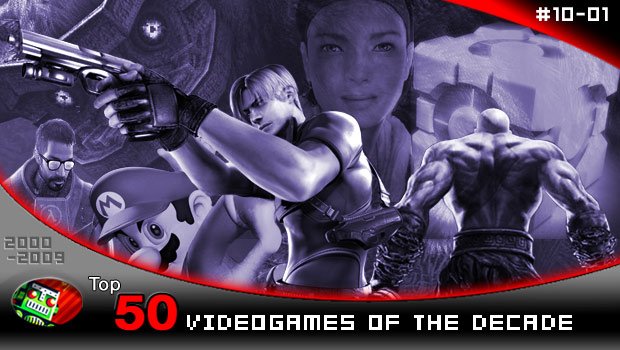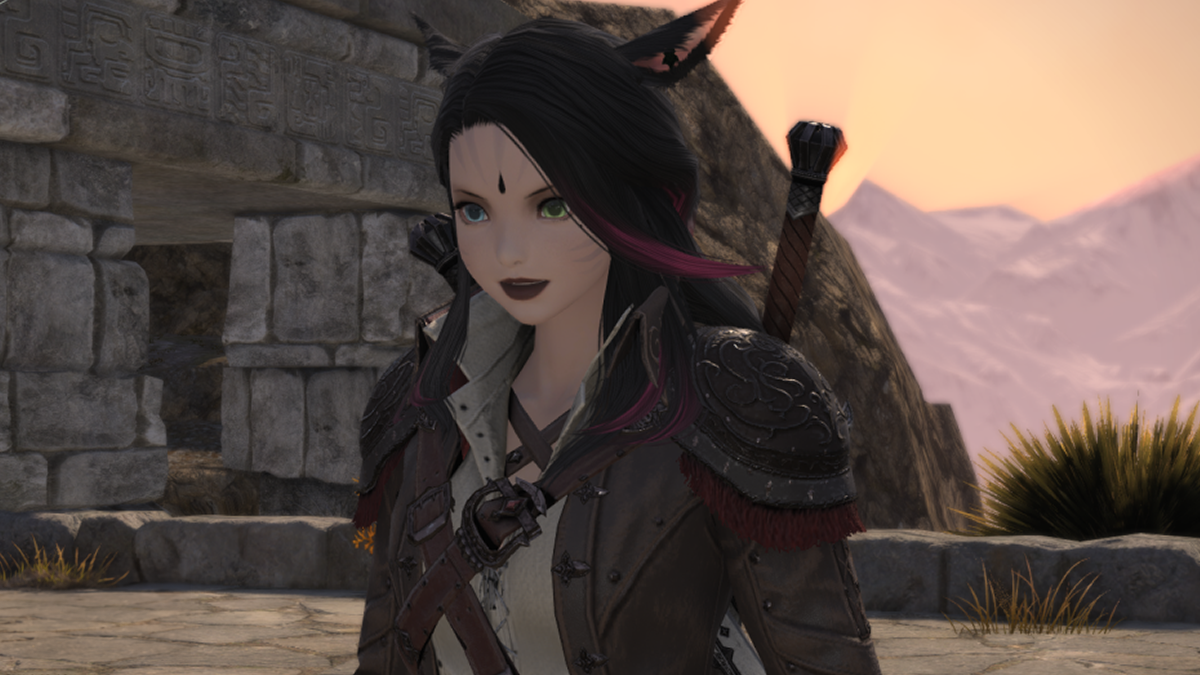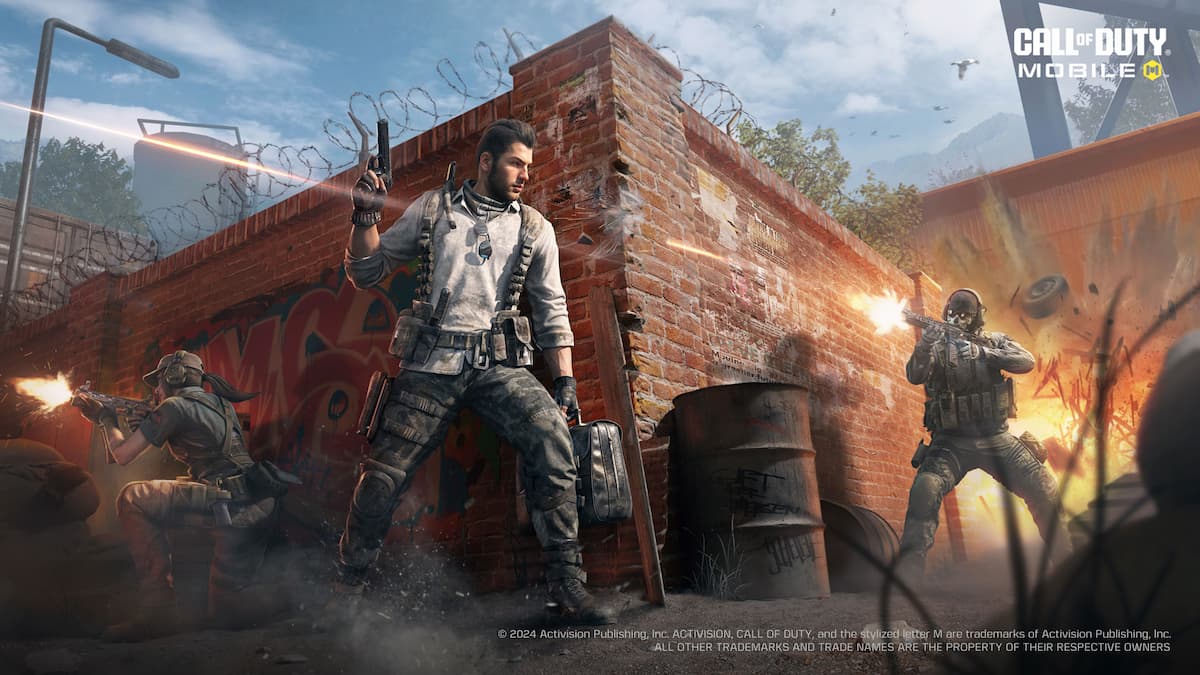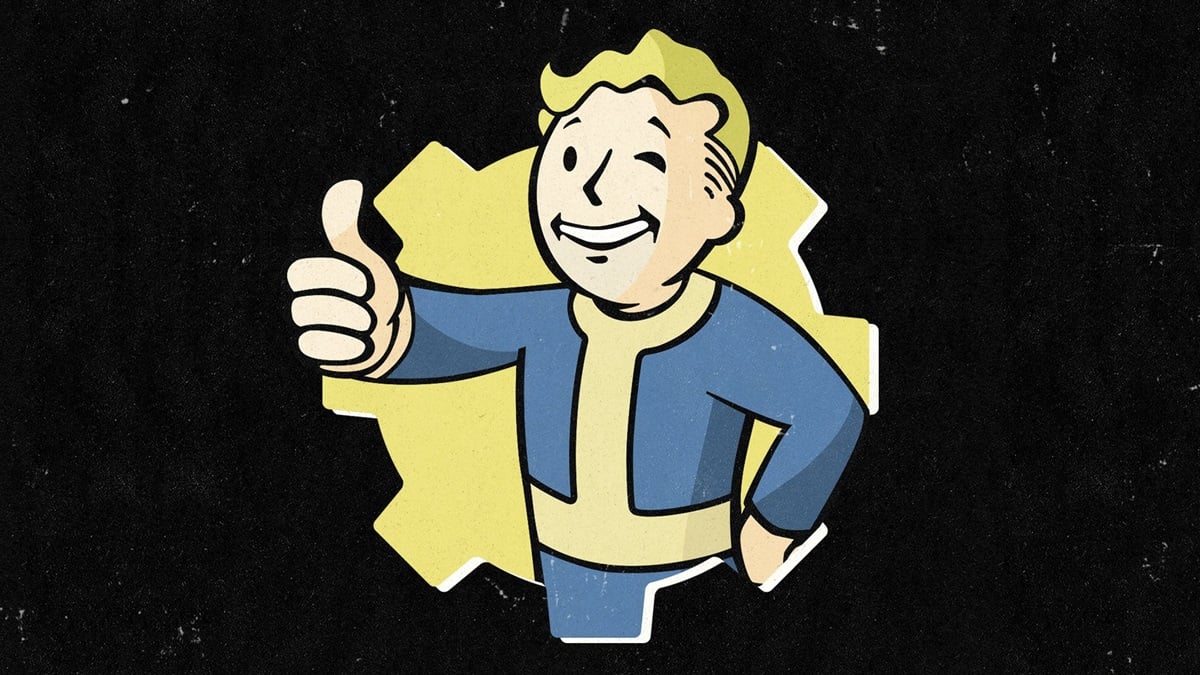In a few weeks, it will be the end of the first decade of the 21st century. To celebrate this milestone, we here at Destructoid picked the best fifty games of the last ten years (the best of the ’00s!). The only rule of this week-long series — other than making sure each game was released between 2000 and today — is that only one game from each series could make the final cut.
This is it! After an entire week of counting down the Top 50 Videogames of the Decade (you can click here, here, here, and here for the other parts), we have reached the final set of games. Part Five (#10-1). The ten best games of the ’00s. THE TOP TEN!
First off, a few “thanks” are in order. I would like to first thank the entire staff of Destructoid — without their help and patience, this mammoth list would never have come together. It was a lot of tiring work, but I am so proud of the final product. Thanks from the bottom of my heart for supporting my compulsive list-making habit.
Next, I have to thank fellow editor Topher Cantler for designing all five header images that accompanied each of the posts all week. I assume you noticed, but all five are completely different and tailored perfectly for each part. Topher is a talented guy and the header pics he created turned out beautiful. Thanks, Toph!
And, finally, and most importantly, I want to thank you guys for reading and supporting these articles all week. While the comments got a little heated at times, I could not be happier with the response. We all can’t agree on which games we love, but it’s so nice to see everyone debating something they are obviously passionate about. You all are the best community on the Internet and I can’t wait to spend the next ten years with you. I hope most of you come back for the inevitable Top 50 Videogames of the ’10s! In my dream world, a game starring dolphins and Dr. Yang will be #1. Who knows what the next decade holds? It’s exciting to think about.
So, let’s get to it. The final list! Our picks for the top ten games of the last decade. Hit the jump for Part Five (#10-1) of the Top 50 Videogames of the Decade! I love making lists! I love you guys! I LOVE VIDEOGAMES!

It feels sacrilegious to say the Resident Evil games were once growing stale, but after the remake of the original game and prequel Zero released on the GameCube, the once revolutionary series started to feel uninspired. Even worse, the completely archaic control scheme and awkward camera angles — while passable on the PlayStation — were completely out of date.
Resident Evil 4 changed everything.
Gone were the pre-rendered backgrounds and set camera angles. Replacing them was a behind-the-shoulder view that followed hero Leon Kennedy as he journeyed through a fully 3D world. Not only did this complete visual overhaul look incredible, it managed to turn the Resident Evil series’ laughable B-movie vibe (“master of unlocking!”) into a game that could genuinely terrify you. It is impossible to forget the first time Leon steps foot in the opening Spanish village and is chased by the now-iconic chainsaw-wielding maniac. It is one of the most visceral and haunting videogame sequences of all time. From the first stunning set piece to the last, Resident Evil 4 is absolute perfection. There may never be a survival horror game as good.

Hyperbole is rampant when talking about videogames you love, but sometimes it is the only way to express a game’s brilliance. With that being said, Super Mario Galaxy is quite possibly the greatest 3D platformer ever created. I know that sounds like a bold statement, but try to think of any other game that does every aspect of platforming better.
Super Mario Galaxy builds off the perfectly-controlled gameplay established in the truly revolutionary Super Mario 64 and, instead of adding a shaky gimmick like in Super Mario Sunshine, it expands on everything that makes a classic Mario game so great — mainly charming characters, creativity as far as the eye can see, and ingenious level design. And instead of a series of grounded stages, Super Mario Galaxy allows Mario to jump, glide, and soar over an entire universe. Watching Mario spring from one perfectly constructed planet to another is entertaining, but grabbing a Wiimote and feeling the fluidity of everything is absolutely exhilarating.
Super Mario Galaxy doesn’t just feel like the perfect Mario game. It is a perfect Mario game.

Released during one of the busiest videogame holiday seasons in recent memory, Sega’s Valkyria Chronicles for the PlayStation 3 was almost dead on arrival. The game was a tactical role-playing game (already a tough sell!), and to people unfamiliar with the genre, it looked complex and overcomplicated (it’s not at all!).
But over the last year, as more and more people started playing it, Valkyria Chronicles grew a massive cult following and healthy sales (even spawning an upcoming sequel!). Everyone that played it instantly fell in love with its gorgeous visuals, solid strategy gameplay, and surprisingly moving story. In a way, this slow build only helped the game in the long run. Instead of the over-hyping that curses most big videogame releases, Valkyria Chronicles was able to be sought out by gamers rather than shoved down their throats.
And once found, gamers were rewarded with one of the richest, most brilliantly constructed turn-based strategy games ever made, topped off with a powerful, extremely moving story (one that affected me in ways I can’t even describe) and a wonderfully endearing cast of characters. There is an extra special place in people’s hearts for Valkyria Chronicles. It is easily the most pleasant gaming surprise of the last decade.

Back in 2000, Diablo II was unbelievably popular — it was one of the most played and talked-about games of the year. That’s a pretty amazing accomplishment. But what’s really amazing is that you can hop onto Battle.net today (Blizzard’s free online gaming service) and still see around 50,000 people playing the classic hack-and-slash role-playing game. 50,000 people. TEN YEARS AFTER THE GAME’S RELEASE! This die-hard devotion is what makes Diablo II so timeless, and an obsession among certain gamers.
The story in Diablo II is classic Blizzard, involving a dark lord and some mystical powers, but that is not what makes the game so fantastic. The addictive gameplay is what brings people back to this game over and over again. By choosing between a handful of varied classes (Barbarian, Necromancer, and Paladin, to name a few), players enter the isometric realm of Diablo II and explore elaborate, multi-level worlds while fighting an ungodly amount of constantly spawning enemies. Unlike the original game, Diablo II was designed with online play in mind, so jumping into an eight-person party, exploring a randomly-generated dungeon, and collecting loot and gaining levels is hopelessly addictive. It really is one of the most enjoyable gaming experiences you will ever have.

Beyond Good & Evil met a very similar early fate as fellow cult classic Valkyria Chronicles. Both games are incredible, but were released during very competitive times and never received enough initial support. Unfortunately for Beyond Good & Evil, a late sales surge never occurred, forcing the fantastic third-person action/adventure to be played by far fewer people. Which is a real shame, since the game offers one of the richest gaming experiences of the last ten years.
The easiest, attention-grabbing way to explain Beyond Good & Evil to someone who has never played is to simply say it is just like The Legend of Zelda, but starring a girl with a camera instead of sword. This description, though, criminally undermines the actual experience of playing through Beyond Good & Evil. The Ubisoft masterpiece stars some of the most likable, well-rounded characters in the history of videogames, including, but not limited to, the strong, independent main character Jade (best videogame heroine ever?) and her loyal, lovable uncle, the half-pig/half-human Pey’j. The bond between the unlikely pair drives the central story and serves as the emotional core of the stellar, wildly inventive adventure.
Even though Beyond Good & Evil grabs a lot of its various gameplay elements from other games (as mentioned before, The Legend of Zelda seems the most obvious), there is something about the game that makes it feel completely original throughout. Maybe it’s the way the beautifully spun story is told. Maybe it’s the underappreciated direction by Michel Ancel. Maybe it’s the unique, detailed world that always feels alive. Whatever the specific reason, Beyond Good & Evil is a videogame that is easy to fall in love with. Once it is over, the experience sticks with you, making it almost impossible to forget. Not that you would ever want to.

Choosing between the original God of War and God of War II is like choosing between a bowl of chocolate ice cream topped with sprinkles or a bowl of chocolate ice cream topped with sprinkles and covered in hot fudge. Sure, the second choice is a little tastier, but no matter which one you choose, you are in for a delicious, mouth-watering treat.
The original God of War is a master class in badass game design (the battle with the Hydra is a thrill ride!), but the sequel truly takes everything up a notch. The polished gameplay transitions perfectly from fighting massive enemies with a one-of-a-kind fighting mechanic, to solving genuinely challenging environmental puzzles that are magnificently designed, to screen-filling, QTE-abundant (quick time event) boss battles that really need to be seen to be fully appreciated. Based on pace and design alone, nothing comes close to God of War II. From its opening, epic battle with the towering Colossus of Rhodes to its final, jaw-dropping sequence in the loom chamber of the Fates, God of War II never ceases to impress. And don’t feel bad about cheering after ripping out the eye of a Cyclops. That guttural, visceral connection is what God of War II is all about!

The world that Valve creates in Portal is extraordinary. Sure, most of the critical acclaim is placed on the first-person puzzle game’s unique and revolutionary gameplay — and rightfully so! — but what elevates Portal from a fancy puzzle game to a fully realized videogame experience are the remarkable details that permeate the game’s every nook and cranny. Main character Chell is not just blindly journeying through a series of levels in a complex facility, creating portals that she can teleport through to access new areas and solve increasingly challenging puzzles. No, she is part of a videogame world that hosts a remarkably cohesive, inspired journey from start to finish.
The details present in Portal — from the glass viewing booths that line the facility to the hilarious and terrifying guidance from artificial intelligence GLaDOS — are absolutely superb. The puzzle mechanic itself is intelligently designed, but it never feels overwhelming. Chell’s adventure — ending with the now-legendary song “Still Alive” — never hits a false beat. In fact, it can be argued that the final climatic sequence of Portal (the one that starts right after an encounter with a certain fiery pit) is one of the most surprising and satisfying videogame conclusions in history. Portal amazes you with its gameplay, but blows you away with its creativity.

Despite its completely retro (but gorgeous!) presentation, Mother 3 may have the most complex, mature, and heart-wrenching story of any videogame of the last decade. The tragically beautiful tale of Lucas, his family, and the complicated characters that surround them is both powerful and unbelievably emotional. If you haven’t played the game, you are missing out on an experience that you will never forget for the rest of your life. True, Mother 3 may hold the honor of being the Japan-only game with the highest demand for an international release, but thanks to the two-years-in-the-making fan translation patch provided by the hard-working heroes at Starmen.net, the game has found a brand new audience in the West! (Just make sure to follow the rules and make it a brand new, legal audience.)
The fervor to get the game released outside Japan is understandable, since Mother 3 is the direct sequel to the incredible EarthBound for the Super Nintendo — a game with a massive following of its own. Not only is Mother 3 a vastly superior game (and that’s saying a lot!), it takes a similar presentation and gameplay style and adds little detailed touches, and, as mentioned early, a much darker story to mold a sophisticated role-playing game wrapped up in a colorful, almost childlike package.
Mother 3 is a game that looks like it could have come out in the early ’90s, yet it sits high at the top of a list of the best games that came out in the new millennium. Despite all the advanced technology, it just goes to show you that, as long as a videogame has a strong story and great gameplay, it doesn’t matter how many polygons can be displayed on the screen at one time.
Mother 3 may be the last game of its kind to ever be released. It truly is something special.

Here we are with Half-Life 2, a game many people may have predicted would be ranked very high on this list of the best games of the decade — we here at Destructoid cannot be accused of holding back our love for the game. But every single bit of praise we have thrown at Half-Life 2 is completely deserved. The game is an undisputed masterpiece.
The original Half-Life really raised the bar in terms of what a first-person shooter could do — more specifically, how a solid story could be presented from a first-person perspective. Half-Life 2 maintains this stellar presentation and continues the story of never-seen, crowbar-wielding protagonist Gordon Freeman as he bands together with fan favorite Alyx Vance (best videogame heroine ever?) and robot DOG to try and save the world from the evil Combine. The story in the game is expertly told through the eyes of Gordon — the game has no cutscenes; everything is, technically, one continuous shot — and contains some unbelievably powerful moments in the form of surprisingly moving character interaction and shocking plot twists. The game has an uncanny ability to make you care about every single friendly character you meet.
So far, the original Half-Life 2 and its two expansion sequels — Episode One and Episode Two — have been released, with a third, highly anticipated Episode on the way. Half-Life 2’s quality is so far beyond a typical first-person shooter, that even non-fans of the genre are impressed by the way the game tells its exciting tale. Every location that Gordon visits in the lengthy, meticulously-designed game contains a handful of ridiculously memorable moments, that by the time the player reaches the impossible-to-describe, thrilling conclusion of Half-Life 2 – Episode 2, they are gasping for breath and bowled over by what they just experienced.
Half-Life 2 is a shining example of what videogames can accomplish, both technically and emotionally.

The first decade of the new millennium was a turning point for videogames. With new technology at their fingertips, designers could imbue so much feeling into their videogames that their creations could be anything of their choosing! This is why true lovers of videogames believe the medium they are so passionate about is unquestionably a form of art. Videogames are not at all a mindless series of beeps and blinks. Some videogames have the power to elicit just as much emotional response as any soaring aria, lush painting, or dramatic monologue ever could (maybe even more so!).
The prime example of this — and the reason it is the #1 game on our list of the Top 50 Videogames of the Decade — is Shadow of the Colossus. The masterpiece (from the artistic mind of creator Fumito Ueda) is the perfect representative of the last ten years of gaming. It combines unique gameplay, gorgeous visuals, and pure imagination in such a perfect way that it elevates the entire medium of videogames.
Shadow of the Colossus follows hero Wander in a vast, stark world as he hunts down and violently kills sixteen massive colossi to presumably save the woman he loves. To do this, he journeys across the surrounding, abandoned landscape to search for the giant beasts atop his trusty horse Agro. The story is deceptively simple, but it unfolds in such a beautiful way.
Everything about Shadow of the Colossus shines. The game only contains nineteen characters (give or take a few extra at the beginning and end): Wander, his true love, Agro, and the sixteen completely innocent, majestic colossi. Using almost no dialogue, the game has the player question things like morality, life and death, passion, courage, unflinching loyalty, and noble sacrifice. Outside of the peacefulness and breathtaking scope of wandering around the huge world, there are specific moments in Shadow of the Colossus that will make you cry, others that will make you gasp, and still others that will leave you speechless. The game is a masterful work of art and a gaming experience like no other.
Shadow of the Colossus is the best videogame to be released in the first decade of the 21st century.
———-
This list was 10 years, 120 months, 520 weeks, 3,652 days, 87,672 hours, 5,260,320 minutes, and thousands of videogames in the making. Best decade EVER!
Now that the list is done, let the discussion begin! What do you think about the final list? What inclusions do you love? Which do you not agree with? Anything left off that you are surprised by? Shocked that there’s no Halo? No Sims? Like I said before, we are super-proud of our final list of 50, but anything and everything is always up for debate! Let us know what you think in the comments.
Thanks again for reading! Here’s to the next incredible decade in gaming …
![]()
Part One – #50-41
50. Metal Slug 3
49. Star Wars: Knights of the Old Republic
48. Phoenix Wright: Ace Attorney
47. Vagrant Story
46. Super Smash Bros. Melee
45. Team Fortress 2
44. WarioWare: Twisted!
43. Banjo-Tooie
42. Psychonauts
41. Braid
Part Two – #40-31
40. Kingdom Hearts
39. Rock Band 2
38. Marvel vs. Capcom 2
37. Lost Odyssey
36. Prince of Persia: The Sands of Time
35. Tony Hawk’s Pro Skater 3
34. Call of Duty 4: Modern Warfare
33. BioShock
32. Katamari Damacy
31. Civilization III
Part Three – #30-21
30. Grand Theft Auto: San Andreas
29. Shenmue II
28. Left 4 Dead
27. Skies of Arcadia
26. Paper Mario
25. Uncharted 2: Among Thieves
24. Dragon Quest VIII: Journey of the Cursed King
23. Cave Story
22. Ico
21. Ikaruga
Part Four – #20-11
20. Final Fantasy IX
19. World of WarCraft
18. Persona 4
17. Pikmin 2
16. Deus Ex
15. Silent Hill 2
14. Okami
13. Metroid Prime
12. Metal Gear Solid 3: Subsistence
11. The Legend of Zelda: The Wind Waker
Part Five – #10-1
10. Resident Evil 4
9. Super Mario Galaxy
8. Valkyria Chronicles
7. Diablo II
6. Beyond Good & Evil
5. God of War II
4. Portal
3. Mother 3
2. Half-Life 2
1. Shadow of the Colossus




